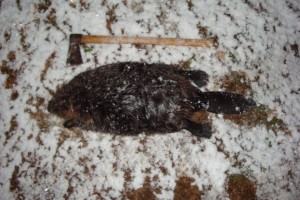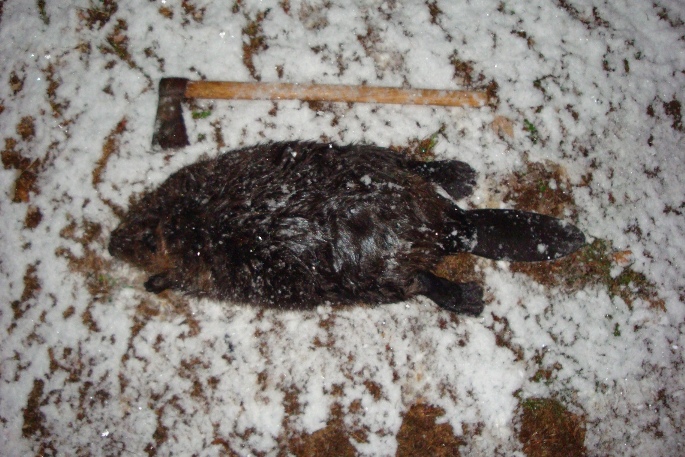Posted by
Isaac on Nov 11, 2011 in
Blog,
Featured |
0 commentsWeather is changing. There is a little snow on the ground and my beaver trapping is proving to be a bit more successful than what I have been doing for other animals. I am only about 300-400 yd. from the house and in a marsh, not a beaver pond or creek, but I have now gotten two beavers in essentially 4 days. I only have 4 snares out in a few different runs and these snares have worked well. Here is the beaver I caught this morning next to my repro French ax made by Jeff Miller (full sized ax, not a hatchet/tomahawk).


The skin will be taken and sold, the tail I will skin out and use for various projects or sell. There is a cool Menominee knife sheath made from a beaver tail that I think I will use the last beavers tail for. I will likely butcher out the carcass for meat to eat, and the castor glands will be made into a lure for trapping. Here is an excerpt from Lewis and Clark’s journal that describes making castor lure. Thanks to the Manual Lisa Party of the AMM (American Mountain Men) for digging this out and posting it online.
Captain Lewis, January 7, 1806
“Last evening Drewyer visited his traps and caught a beaver and an otter; the beaver was large and fat we have therefore fared sumptuously today; this we consider a great prize for another reason, it being a full grown beaver was well supplied with the materials for making bate with which to catch others. This bate when properly prepared will intice the beaver to visit it as far as they can smell it, and thus I think may be safely stated as a mile, their sense of smelling being very acute. To prepare beaver bate, the castor or bark stone is taken as the base, this is gently pressed out of the bladderlike bag which contains it, into a phiol of 4 ounces with a wide mouth; if you have them you will put from four to six stone in a phiol of that capacity, to this you will add half a nutmeg, a dozen or 15 grains of cloves and thirty grains of cinimon finely pulverized, stir them well together and then add as much ardent sperits to the composition as will reduce it the consistency mustard prepared for the table; when thus prepared it resembles mustard precisely to all appearance. When you cannot procure a phiol a bottle made of horn or a tight earthen vessel will answer, in all cases it must be excluded from the air or it will soon loose its virtue; it is fit for uce immediately it is prepared but becomes much stronger and better in about four or five days and will keep for months provided it be perfectly excluded from the air. When cloves are not to be had use double the quantity of Allspice, and when no spice can be obtained use the bark of the root of sausafras; when sperits can not be had use oil stone of the beaver adding mearly a sufficient quantity to moisten the other materials, or reduce it to a stif past. It appears to me that the principal uce of the spices is only to give a variety to the scent of the bark stone and if so the mace vineller and other sweetsmelling spices might be employed with equal advantage. The male beaver has six stones, two which contain a substance much like finely pulvarized bark of a pale yellow colour and not unlike tanner’s ooz in smell, these are called the bark stones or castors; two others, which like the bark stone resemble small bladders, contain a pure oil of a strong rank disagreeable smell, and not unlike train oil, these are called the oil stones; and 2 others of generation. the Barkstones are about two inc[h]es in length, the others somewhat smaller all are of a long oval form; and lye in a bunch together between the skin and the root of the tail, beneath or behind the fundament with which they are closely connected and seem to communicate.”
The Journals of the Lewis & Clark Expedition, Gary E. Moulton, editor, University of Nebraska Press, Vol. 6, ppgs 174-175






Leave a Reply